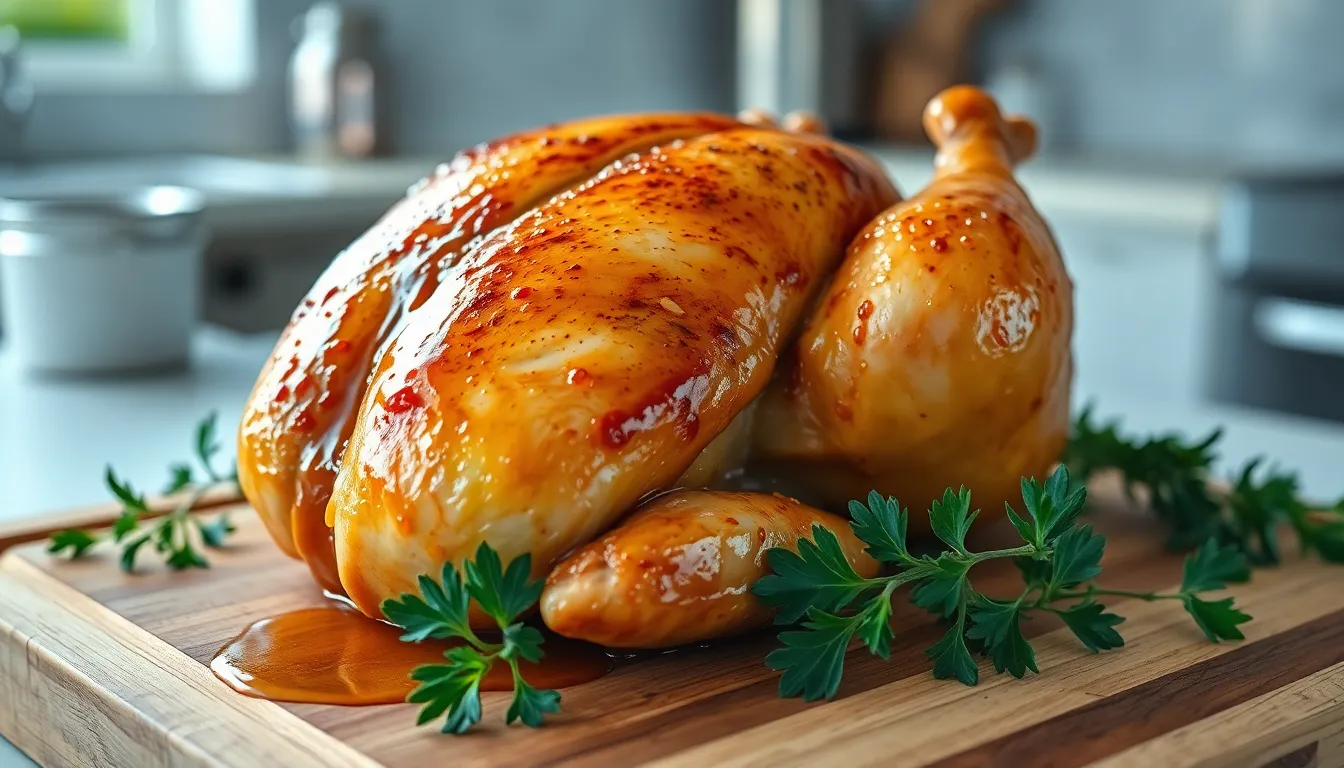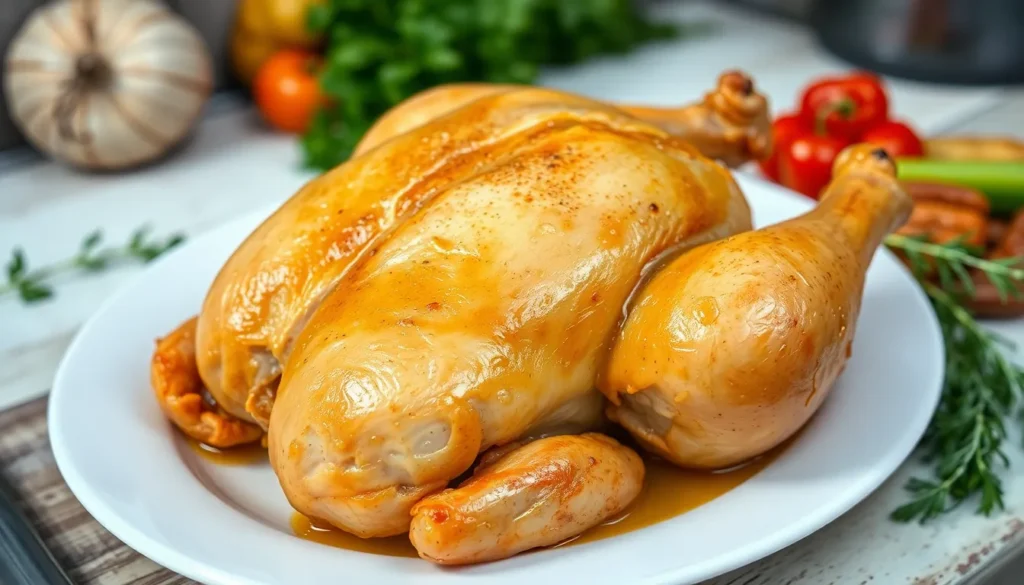When it comes to cooking chicken, knowing what to look for can make all the difference in ensuring a delicious meal. Cooked chicken should not only be visually appealing but also safe to eat. Understanding the signs of perfectly cooked chicken can help anyone avoid undercooked or overcooked meat.
The color, texture, and juices of cooked chicken play a crucial role in determining its doneness. Whether it’s a golden-brown roast or sautéed pieces in a stir-fry, recognizing these characteristics can elevate culinary skills. This guide will explore what cooked chicken looks like, providing essential tips for achieving that perfect finish every time.
Table of Contents
ToggleUnderstanding Cooked Chicken
Understanding the appearance of cooked chicken is essential for ensuring food safety and achieving a flavorful dish. Recognizing specific visual indicators can help confirm that chicken is properly cooked.
Importance of Visual Indicators
Visual indicators play a vital role in identifying perfectly cooked chicken. Color, texture, and moisture level provide critical insights:
- Color: Properly cooked chicken should appear white or light brown throughout. Avoid any pink in the meat or juices, especially near the bone.
- Texture: Cooked chicken should feel firm and springy to the touch. Overcooked chicken becomes dry and tough, while undercooked chicken remains soft and raw.
- Juices: Clear juices indicate doneness. Pink juices signal insufficient cooking, which poses food safety risks.
Common Cooking Methods
Different cooking methods yield distinct visual characteristics in cooked chicken. Understanding these methods assists in identifying doneness:
- Roasting: Roasted chicken typically shows golden-brown skin, crisped edges, and juicy, white meat.
- Grilling: Grilled chicken displays grill marks on the surface, with a slightly charred appearance and a moist interior.
- Boiling: Boiled chicken often appears pale and soft, with the meat readily separating from the bone, indicating thorough cooking.
- Sautéing: Sautéed chicken features a golden color and a caramelized exterior, with tender meat inside.
Recognizing these visual cues ensures the chicken is not only safe to eat but also delicious and enjoyable.
Characteristics of Properly Cooked Chicken

Recognizing the characteristics of properly cooked chicken is crucial for ensuring safety and quality. Key indicators include color, texture, juiciness, and tenderness.
Color and Texture
Cooked chicken should present a consistent white or light brown color throughout. Darker areas may indicate undercooked portions. The texture should feel firm and springy when pressed. Any rubbery or overly soft texture suggests undercooking.
Juiciness and Tenderness
Properly cooked chicken exhibits clear juices that run freely when cut. If juices appear pink or red, the chicken is likely undercooked. Cooked chicken should also feel tender when bitten. Overcooked chicken may become dry and tough, affecting mouthfeel.
Signs of Undercooked Chicken
Recognizing signs of undercooked chicken is crucial for food safety. Key indicators include unsafe color changes and internal temperature measurements.
Unsafe Color Indicators
Unsafe color indicators can reveal undercooked chicken. The meat should appear white or light brown throughout. Pink, red, or translucent areas, especially near the bone, indicate that the chicken hasn’t reached a safe internal temperature. Additionally, any gelatinous texture or excessive redness in juices signals undercooking. Dark areas may also indicate that parts of the chicken are not fully cooked.
Checking Internal Temperature
Checking internal temperature is essential for ensuring chicken is properly cooked. The USDA recommends an internal temperature of 165°F (74°C) for all poultry. A food thermometer provides the most reliable measurement. Insert the thermometer into the thickest part of the chicken, avoiding bones for an accurate reading. If the temperature reads below 165°F (74°C), the chicken requires further cooking to ensure safety.
Tips for Identifying Cooked Chicken
Recognizing perfectly cooked chicken relies on several visual and textural indicators. Understanding these can enhance food safety and enjoyment.
Visual Cues to Look For
- Color: Cooked chicken should display an even, light brown or white color throughout. Pink or red areas, particularly near bones, suggest undercooking.
- Juices: Juices that run clear when the chicken is cut indicate proper cooking. Juices that remain pink or red can signal undercooked meat.
- Texture: Cooked chicken tends to feel firm and springy. A rubbery or excessively soft texture may indicate undercooking.
- Surface: A well-cooked chicken has a nice golden-brown crust without charred spots. An uneven surface may suggest inconsistent cooking.
Importance of Cooking Techniques
- Roasting: This method browns the exterior while keeping the inside moist. A uniform color signals doneness.
- Grilling: Direct heat creates a distinct char while locking in juices. Look for grill marks and even coloring.
- Boiling: Boiling provides a consistent cooking environment. Ensure chicken floats in clear broth to confirm it’s cooked through.
- Sautéing: This method browns the chicken quickly. Look for a golden surface and firm texture to ensure doneness.
By being attentive to visual cues and utilizing effective cooking techniques, cooks can achieve safe and delicious chicken dishes.
Recognizing the visual signs of cooked chicken is crucial for both safety and flavor. By paying attention to color texture and juiciness cooks can confidently serve delicious meals. Properly cooked chicken should be white or light brown throughout and feel firm with clear juices running when cut.
Understanding these indicators not only enhances the dining experience but also ensures adherence to food safety standards. Using a food thermometer to check for an internal temperature of 165°F is a reliable method to guarantee doneness. With these insights cooks can avoid the pitfalls of undercooked or overcooked chicken and create satisfying dishes every time.





